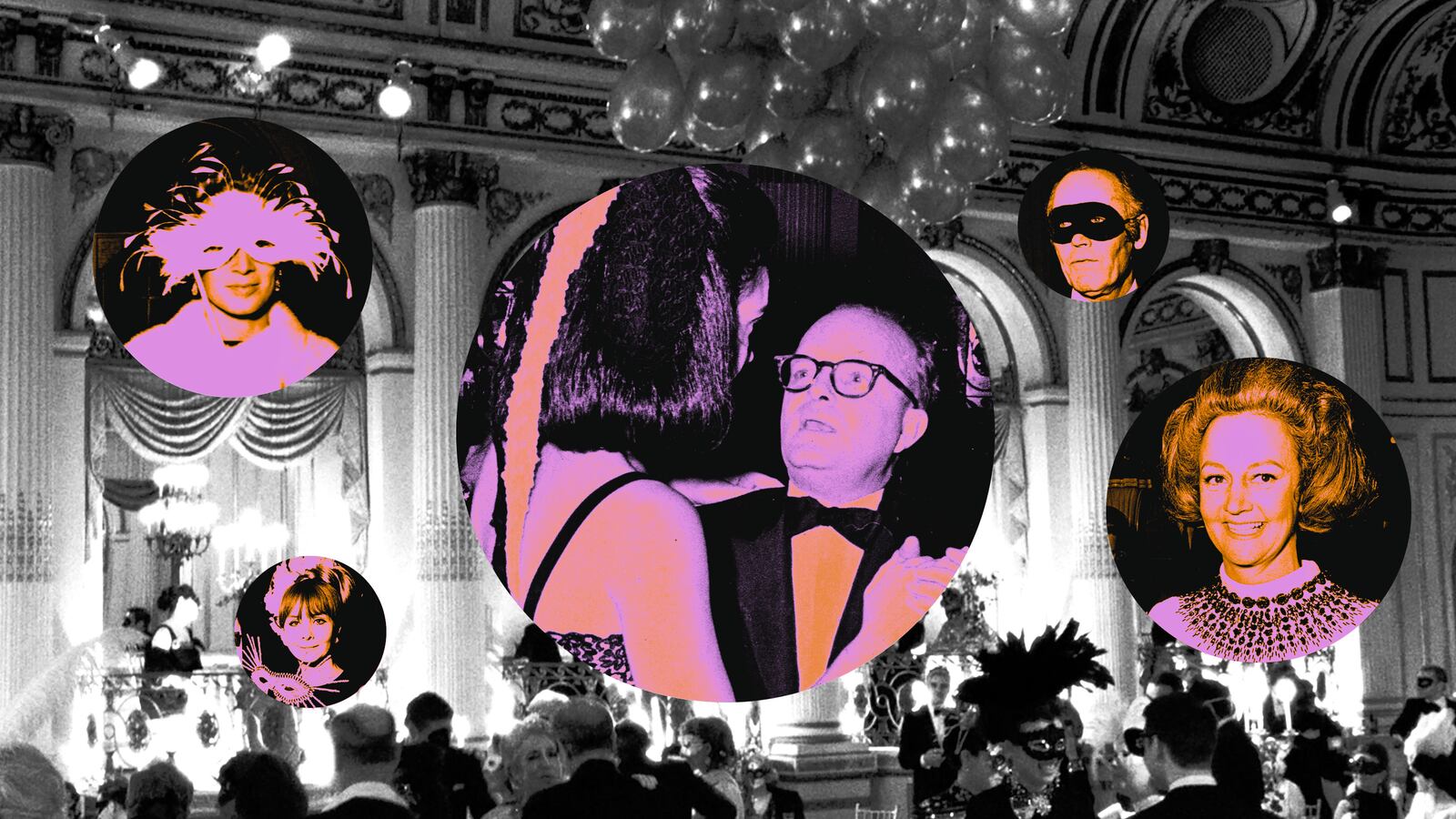On Nov. 28, 1966, author Truman Capote threw a party so grand, star-studded, and exclusive that it singlehandedly defined its guests’ societal status. “It was an invitation that people were clawing to get,” actress Candice Bergen recently said of the Black and White Ball, Capote’s infamous masked affair. “It was New York at its most vicious.”
The soirée, held at New York’s Plaza Hotel just four days after Thanksgiving, was the literal talk of the town for months leading up to the event. Those who mingled in circles of high society and celebrity spent weeks vying for an invitation, and gossiping about who would and would not be on the list. They suffered through the holiday when all they really wanted to do was make sure that the finishing touches on their designer clothes were being attended to. And Capote, the glutton for attention he was, relished every last drop of anticipation.

Truman Capote at his Black-and-White Ball at the Plaza Hotel New York, with Katharine Graham, the publisher of The Washington Post.
Harry Benson/Getty ImagesThat same year, documentary filmmakers Albert and David Maysles followed Capote for their short film With Love from Truman. The candid interviews led to a friendship between the writer and the two brothers. While Albert attended the ball as a guest, the FX series Feud: Capote vs. the Swans ponders what it might have been like if both siblings brought their cameras into Capote’s modern aristocracy.
This thought experiment comprises the season’s third episode, “Masquerade 1966,” in which director Gus Van Sant brilliantly recreates the Maysles’ signature style for a fictional take on the preparation for the gala. But though this peek behind the scenes is imagined, it feels oddly real—like watching never-before-seen footage unearthed from an archive—thanks to Van Sant’s keen, referential direction and writer Jon Robin Baitz’s elegant script. Baitz infuses the episode with all of the raw, very real drama that Capote manufactured like his own personal currency, as he strung even his beautiful best friends, the Swans, along by implying that they could all be the party’s guest of honor. The episode is a feat unto itself, and a fine example of how to meld past and present, fiction and reality, for something unique.
Before the episode’s premiere, Van Sant and Baitz spoke to The Daily Beast’s Obsessed about how they recreated the Maysles’ style, kept the brutally effusive Capote from becoming a villain, and teased some of Capote vs. the Swans’ other, upcoming tricks.

The Black and White Ball in Feud: Capote vs. the Swans.
FXThe show is called Feud, and that word does suggest some level of spiteful cattiness. But you both have turned this legendary war among upper-crust New York society into something that is not just venomous but also very emotionally resonant and relatable. Why was it important to convey that sense of humanity in this larger-than-life story?
Van Sant: The humanity is sort of a prerequisite for telling almost any story. You want the humanity to be tangible, to bring you along so you laugh and cry.
Baitz: You want to be able to empathize with what’s going on under the surface of that life. Most stories have a built-in cautionary tale. We all have versions of Truman’s FOMO. Thankfully, most of us are able to rein that in and tell ourselves the most important thing, which is that nobody’s watching. Just be you. But this is like being underwater: The deeper you get, the more pressure gets to you. And I want people to feel what Ryan [Murphy, executive producer] and I noted with [the concept of] the end of a world, and that Gus translated into a visual vocabulary.
Speaking of visual vocabulary, the Black and White Ball episode is astounding. Gus, I was fascinated by the way that you were able to cleverly convey the Maysles’ style without it feeling like mimicry. Was achieving that balance a challenge?
Van Sant: It’s been done a lot, and I don’t know that I’ve ever done it except with home movies. But I welcomed the opportunity to actually do that because you’re mimicking or materializing something that I knew very well: the Maysles’ films. They were the new journalists, the cinema journalists. So there are many different examples you can find to emulate it. It wasn’t too hard.

Truman Capote dances with Wendy Vanderbilt at his Black-and-White Ball in the Plaza Hotel, New York, Nov. 28, 1966. To the left, Katharine Graham, publisher of The Washington Post and Capote’s guest of honor, dances with an unidentified man. To the right, actress Lauren Bacall dances with choreographer Jerome Robbins.
Express Newspapers/Getty ImagesI’m sure it’s much easier said than done, though, to create something that evokes that handheld style so well that it genuinely feels like something they actually could have made themselves.
Van Sant: In the past—in the ’60s, when this would have been made—cinematographers were freeing themselves of the tripod. And it’s been emulated to the point that now it’s our standard movie style, which is handheld. And handheld today means, like, jerk it around on your shoulder and move it. [Laughs.] The people in the ’60s were trying to hold it really still. They were also trying to get the action, so that was one little aspect of emulating their style. They weren’t trying to make it bumpy, they just…didn’t have a tripod!
The series takes liberties when it comes to filling in prevalent gaps in Capote’s life and his relationship with Babe Paley (Naomi Watts). We see these in haunting dream sequences that speculate upon the manuscript for Capote’s unfinished novel, Answered Prayers. How do you keep these fantastical scenes grounded?
Baitz: You write them by using this magnificent thing that you acquire called good taste. There’s a lot of tailoring in the show; [the Swans have] a lot of appointments at couture houses. [The question for us] is about building the kind of dress that tells the story. It walks a tightrope, you just have to know where you are on the tightrope. I think Ryan, Gus, and I were on the same page about showing a decline in this society.

Naomi Watts as Babe Paley in Feud: Capote vs. the Swans.
FXI think that “end-of-an-era” feeling is very prevalent, especially toward the end of the season.
Van Sant: But also at the center of it is Babe and Truman’s relationship, because [we address] their friendship in general within the context of their own mortality. They’re of an advanced age, so they’re sharing the good times until something goes wrong and their friendship is in peril.
Baitz: We tried to do the thing, in terms of the liberties, that Truman was doing in his storytelling.
I was going to suggest that. There seems to be a correlation between the way Truman wrote and the way that you wrote the series, Jon.
Baitz: Yeah, I tried to take into account his vocabulary. The credit for the structural collage part is all Ryan. I just transcribed the idea onto the page.
The dialogue jumps between cutting toxicity and a more beautiful examination of friendship and forgiveness. Jon, how do you, as a writer, attain that equilibrium without it feeling false or forced?
Baitz: Intimacy, I suppose. I think that, in order to write, you just have to have a bullshit detector, as Norman Mailer said. I think that comes with experience. Much of writing that is successful has a kind of danger to it. It’s like cooking, really. You want layers of taste. There is that element in it. Somewhere… there’s the scent of saffron, but underneath that is maybe, forgive me, fennel seed.
Van Sant: [Laughs.]
Baitz: And I’m so sorry to use a cooking metaphor! But I think it describes it well.






